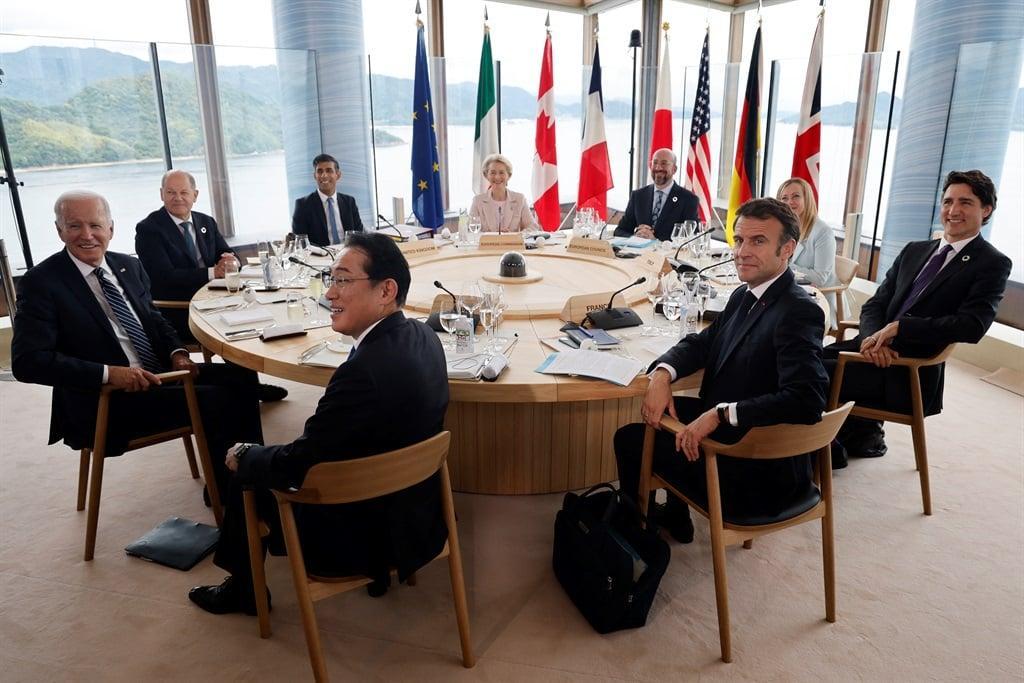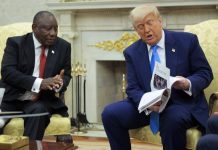Africa-Press – South-Africa. In Russia’s war with Ukraine and China’s dramatic rise, America and NATO did not just find bogies for their foreign and security policies; they also found a new raison d’étre – one they have been searching for since the end of the Cold War, writes Chris Landsberg.
The acronym VUCA – Uncertain, Unpredictable and Ambiguous – was first used in the US War Army College in 1987, and published in 1991 by Herbert Barber, to describe the lead up to, and aftermath of the collapse of the Berlin Wall, the “end” of the Cold War. It was invoked to depict the post-Cold War security, political and economic architecture.
The concept invoked by the acronym now seems passe as the world faces an even more unpredictable and fluid post-post-Cold War (dis)order, with the hallmarks of the making of an anarchic second Cold War.
The post-Cold War-Cold War, is characterised by a complex and often acrimonious post-Cold War security and pollical architecture.
The VUCA world – Volatile, Uncertain, Unpredictable and Ambiguous – appears to be changing towards even more problematic, distressing, unpredictable and fluid features. This era can be described as a UTAC order, a phrase I coined with Shamila Singh to characterise the current international context as Unchartered, Turbulent, Anarchic, and Combustible.
Shifting alliances
Alliances are constantly shifting, and in the process of being remade, are renegotiated and recrafted, and unanchored in any firm principles, result in a global order that is becoming more unpredictable.
The volatility of the combustive emerging situation is of such an order that playing around with a nuke option is one that cannot be ruled out.
Speaking at the Munich Security Conference in February 2021, US President Joe Biden stated:
The challenges we are facing today are different. We are at an inflection point… between those who argue that, given the changes we face, from the fourth industrial revolution to a global pandemic, that autocracy is the best way, and those who argue that democracy is essential – essential to meeting those challenges.Biden thus incepted his administration’s foreign policy doctrine: democracy vs autocracy. And, of course, in this tussle, the US will lead the forces of democracy.
In June 2021, Biden went on further to suggest that “whether it is ending the Covid-19 pandemic everywhere, meeting the demands of accelerating climate change crisis, or confronting the harmful effects of the governments of China and Russia, the United States must lead the world from a position of strength”.
But it was the March 2022 US Congressional Research Service Report, “Renewed Great Power Competition: Implications for Defence”, which outlined the strategic posture and intent of the US more starkly:
The US goal of preventing the emergence of regional hegemons in Eurasia, though longstanding, is not written in stone – it is a policy choice reflecting two judgments: (1) that given the amount of people, resources and economic autonomy in Eurasia, a regional hegemon in Eurasia would represent a concentration of power large enough to be able to threaten vital US interests.It went further to assert that Eurasia is not dependably self-regulating in terms of preventing the emergence of regional hegemons, meaning that the countries of Eurasia cannot be called on to prevent, through their own actions, the emergence of regional hegemons and may need the assistance from one or more countries outside Eurasia to be able to do this dependably.
So in May 2023, they went to the Eurasian heartland. The power-obsessed G7 nations, who typically view the world through balance of power, not balance of force lenses, concluded their G7 summit in the historic city of Hiroshima during the week of 18–21 May. What is interesting about Hiroshima is that it was the first city in the world that had to endure nuclear weapons when the United States launched two atomic bombs at Hiroshima and Nagasaki on 6 and 9 August 1945, and was, therefore key in signalling the start of the Cold War.
Fast forward 70 years later, and the G7 members, many of which are caught up in a realist power-politics prism, met in Hiroshima.
One of the major outcomes was the declaration made by British Prime Minister Rishi Sunak, who declared China to be “the greatest threat to international peace and security”. With that declaration, Sunak – and the G7 – effectively announced that we have now entered the new Cold War.
It should be borne in mind that it is the G7 who made this declaration, not China. This mirrors NATO’s expansion eastward in Europe, and its exercises with Ukraine helped to push Russian president Vladimir Putin to declare a deadly and costly war.
For the G7 to declare China as the greatest threat to ‘peace and security’ is tantamount to a declaration of war, albeit it a cold one.
Provoking China
In the case of Russia, Putin started the war, but NATO triggered it. With China, the G7 is attempting to provoke China into a war, but with its doctrine of “the peaceful rise of China”, Beijing is unlikely to enter into an unnecessary, and deadly war. The G7 will, of course, continue with sabre rattling over the Chinese straits, especially when incited by Washington, but the Chinese are adept at playing the “long game”, and will likely respond with economic statecraft measures instead, rather than an aggressive war.
China has repeatedly tried to talk “the West” out of its bellicose rhetoric and belligerent postures. Even the high priest of realpolitik, the 100-year-old Henry Kissinger, has warned that America and China seem to be on a collision course and posits America, not China, as the provocateur.
Beijing has repeatedly centred “dialogue” and accommodation with Washington and its lesser allies, but its pleas for a refashioning of the terms on which the international order is made continue to fall on seven deaf ears, and the tone-deaf 24 other NATO mini-me’s, with the exception such as Turkey, that China has warned of “catastrophic” consequences.
China is too shrewd and cautious to be rushed into a hot war by mere provocation. But it is capable of reacting with harsh non-military measures. This is almost a guarantee. Ironically, the “Western powers” that declared China ‘the greatest threat’ were quick to clarify, “we don’t have a ‘de-coupling’ in mind, merely a ‘de-risking’ from China”. Recklessness notwithstanding, the G7 and NATO seem mindful of the power that China can wield.
To be sure, China has their own expansionist, and even imperial, ambitions. In Africa, the real geo-political play-ground where the New Post-Cold War-Cold war will play out, China will continue with its crude Belt-and-Road transactional project: in exchange for ‘non-interference’, Africans are given preferential access to loans and help with infrastructural development, while China gets preferential rights to aggressive resource extraction. They will not take the dragon’s eye off its main purpose – the unprecedented and dogged growth, industrialisation and development of China and the Chinese people.
But so daring have NATO been that they pushed Putin to the precipice before 24 February 2022, with their military exercises with Ukraine, with expansionist projects deep into Russia’s backyard.
Push for regime change
The Russians warned for at least two decades that NATO’s expansion eastward posed an “existential” threat to Russia and a real danger to Russia’s self-preservation. Putin long warned that NATO expansionism does not have any relation with the modernisation of the alliance itself or even the general security in Europe. On the contrary, it represents a serious provocation that reduces the level of mutual mistrust.
Though the Ukraine-Russia war has dragged on far longer than Moscow anticipated, the objective of the West is no longer just pushing back the Russians. Regime change, by triggering an internal revolt in Russia, is now the aim, even if it be through a coup. A paranoid President Putin, if backed into a tight corner, may toy with the unthinkable idea of the nuclear option – unchartered times with horrific combustible ramifications indeed.
America, Britain and other Western powers are hell-bent on consolidating NATO’s new-found unity, as they push back at any emerging formations, coalitions and alliances that may rival the Western liberal order.
Newsletter
Weekly
Opinions Weekly
Opinions editor Vanessa Banton curates the best opinions and analysis of the week to give you a broader view on daily news happenings.
Sign up
In Russia’s war with Ukraine and China’s dramatic rise, America and NATO did not just find bogies for their foreign and security policies; they also found a new raison d’étre – one they have been searching for since the end of the Cold War.
America, in particular, and NATO in general are determined not just to secure the survival of the ‘Western liberal order’, but to also see it expand to areas where it has not yet taken a hold – in this case even contemplating the “westernisation of Russia”.
In this sense, they have helped to trigger the war, even though it was started by Russia, a war president Putin may very well have been planning before actually executing it. Once the war had started, the conflict with Russia became a rationale for unifying and consolidating NATO power. The objective now is not just the containment of Russia but regime change in Russia. “For God’s sake,” vowed Biden, “this man (Putin) cannot remain in power”. The turbulence and anarchy that will follow are unimaginable.
Enemy number one
NATO’s new raison d’être is no longer a mere restraint of other powers; it is now committed to aggressive hegemonic command and control through regime change, which will become the means. It is likely that this will be extended to enemies beyond the Eurasia fronts. And so, in their minds, though an example has to be made of Russia, China remains enemy number one.
In Hiroshima, the G7 leaders also sent a clear warning to the backers and supporters of their enemies: they too will face the ire and opprobrium. The adage, “you’re either with us or against us” has stood the test of Washington’s foreign policy plank.
South Africa is firmly in the sights of the West as a friend-turned-foe state: a real frienemy. Once the outcome of the “Lady-R” debacle is revealed, America and its allies will stand ready to pounce on the Republic. They wish to make an example. South Africa must brace itself. Here might come our long winter of international discontent.
In a series of essays that focus on the changing global order, I will next focus on the efforts that are being made towards the “international de-legitimisation” of South Africa.
– Professor Chris Landsberg is the SARChi chair in African Diplomacy & Foreign Policy and Director of the Centre for African Diplomacy and Leadership at the University of Johannesburg.
For More News And Analysis About South-Africa Follow Africa-Press






